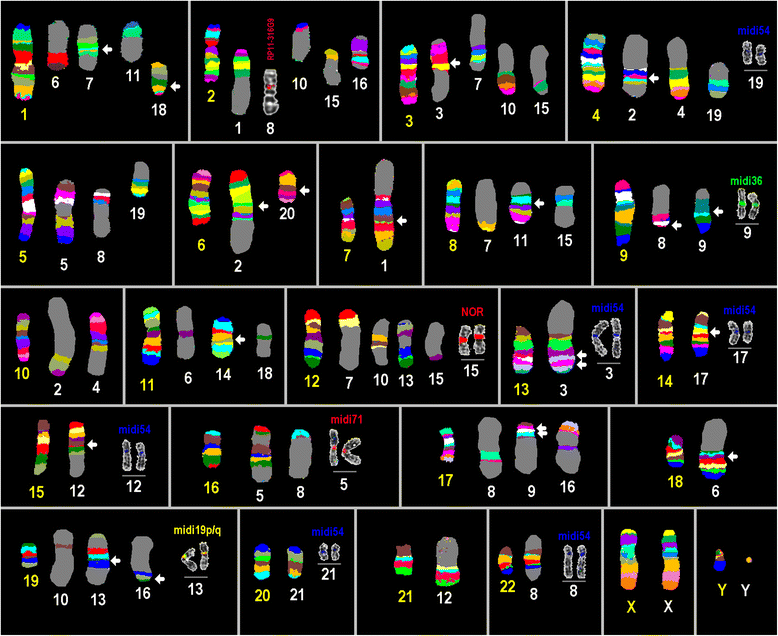Application of multicolor banding combined with heterochromatic and locus-specific probes identify evolutionary conserved breakpoints in Hylobates pileatus
- PMID: 26893612
- PMCID: PMC4758170
- DOI: 10.1186/s13039-016-0228-x
Application of multicolor banding combined with heterochromatic and locus-specific probes identify evolutionary conserved breakpoints in Hylobates pileatus
Abstract
Background: The question what makes Homo sapiens sapiens (HSA) special among other species is one of the basic questions of mankind. A small contribution to answer this question is to study the chromosomal constitution of HSA compared to other, closely related species. In order to check the types and extent of evolutionary conserved breakpoints we studied here for the first time the chromosomes of Hylobates pileatus (HPI) compared to HSA and Hylobates lar (HLA) by means of molecular cytogenetics.
Results: Overall, 68 new evolutionary conserved breakpoints compared to HSA could be characterized in this study. Interestingly, only seven of those were different compared to HLA. However, application of heterochromatic human DNA-probes provided evidence that observed high chromosomal rearrangement rates of gibbons in HPI happened rather in these repetitive elements than in euchromatin, even though most centromeric positions were preserved in HPI compared to HSA.
Conclusion: Understanding genomes of other species and comparing them to HSA needs full karyotypic and high resolution genomic data to approach both: euchromatic and heterochromatic regions of the studied chromosome-content. This study provides full karyotypic data and previously not available data on heterochromatin-syntenies of HPI and HSA.
Keywords: Centromeric positions; Evolution; Heterochromatin; Hylobates lar (HLA); Hylobates pileatus (HPI); Multicolor banding (MCB).
Figures

Similar articles
-
Comprehensive characterization of evolutionary conserved breakpoints in four New World Monkey karyotypes compared to Chlorocebus aethiops and Homo sapiens.Heliyon. 2015 Nov 24;1(3):e00042. doi: 10.1016/j.heliyon.2015.e00042. eCollection 2015 Nov. Heliyon. 2015. PMID: 27441227 Free PMC article.
-
Detailed Hylobates lar karyotype defined by 25-color FISH and multicolor banding.Int J Mol Med. 2003 Aug;12(2):139-46. Int J Mol Med. 2003. PMID: 12851708
-
First Comprehensive Characterization of Phayre's Leaf-Monkey (Trachypithecus phayrei) Karyotype.Front Genet. 2022 Mar 11;13:841681. doi: 10.3389/fgene.2022.841681. eCollection 2022. Front Genet. 2022. PMID: 35360869 Free PMC article.
-
Heterochromatin, satellite DNA, and cell function. Structural DNA of eucaryotes may support and protect genes and aid in speciation.Science. 1971 Dec 17;174(4015):1200-9. doi: 10.1126/science.174.4015.1200. Science. 1971. PMID: 4943851 Review.
-
A rosy future for heterochromatin.Proc Natl Acad Sci U S A. 1994 Jun 7;91(12):5219-21. doi: 10.1073/pnas.91.12.5219. Proc Natl Acad Sci U S A. 1994. PMID: 8031404 Free PMC article. Review.
Cited by
-
Mechanisms of Rapid Karyotype Evolution in Mammals.Genes (Basel). 2023 Dec 31;15(1):62. doi: 10.3390/genes15010062. Genes (Basel). 2023. PMID: 38254952 Free PMC article. Review.
-
Comparative Cytogenetics and Neo-Y Formation in Small-Sized Fish Species of the Genus Pyrrhulina (Characiformes, Lebiasinidae).Front Genet. 2019 Aug 2;10:678. doi: 10.3389/fgene.2019.00678. eCollection 2019. Front Genet. 2019. PMID: 31428127 Free PMC article.
References
-
- Darwin C. The origin of species by means of natural selection. https://www.andrew.cmu.edu/user/jksadegh/A%20Good%20Atheist%20Secularist.... Accessed 24 Dec 2015.
LinkOut - more resources
Full Text Sources
Other Literature Sources
Research Materials
Miscellaneous

